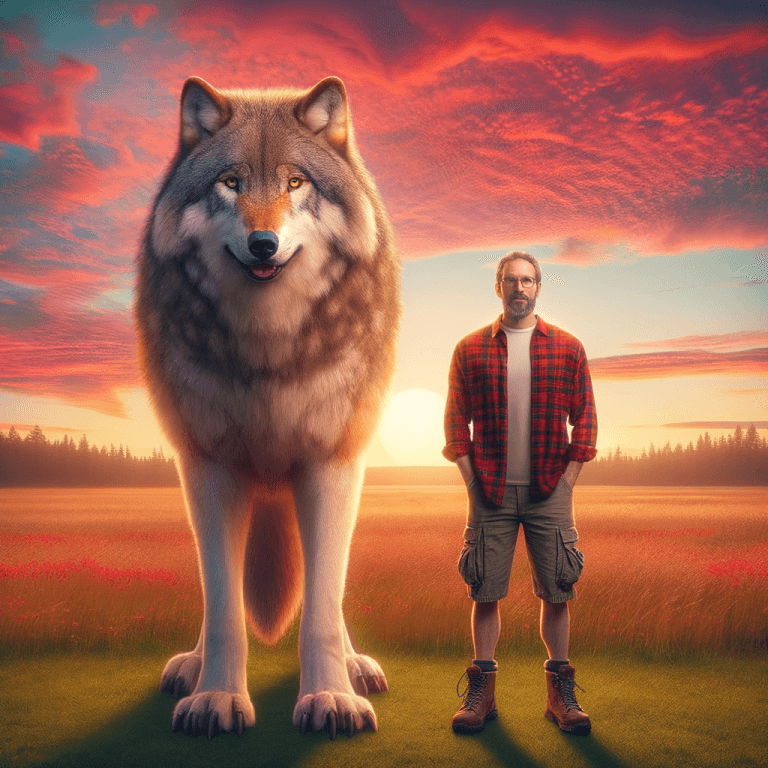Dire Wolf Size
Ever wondered how big a dire wolf is compared to a human? In this article, I’ll explore the average size of a dire wolf and its significance in their predatory abilities. Using a table, I’ll present the size comparison in feet and pounds (and in meters and kilograms) to give you a clear picture of just how massive these creatures were.
Comparing the Size of Dire Wolves to Humans
Find out how the size and weight of dire wolves stack up against the average human, and discover fascinating insights into the physical differences between these ancient creatures and modern humans.
Dire Wolf Size
The average size of a dire wolf is significantly larger than that of the average human. In fact, dire wolves typically stood at around 2.5 feet (76 cm) tall at the shoulder and could weigh up to 150 pounds (68 kg), making them much larger and more robust than the average human. This substantial size gave dire wolves a significant advantage in their predatory abilities, allowing them to take down large prey and dominate their environment.
Dire Wolf Behavior
The behavior and hunting habits of the dire wolf were crucial to its survival and dominance as a predator in its environment. When compared to the average human, the dire wolf’s behavior and hunting habits were significantly different, reflecting its role as a top predator.
Behavior Description
- The dire wolf was known for its pack behavior, often hunting in groups to take down large prey.
- They exhibited strong territorial behavior, defending their hunting grounds from other predators and rival dire wolf packs.
- Unlike modern-day wolves, dire wolves were more robust and had a more powerful bite force, allowing them to take down larger prey.
Comparison to Modern-Day Wolves
When comparing the behavior of the dire wolf to that of modern-day wolves, several key differences become apparent. While modern-day wolves also exhibit pack behavior and territoriality, the dire wolf’s larger size and more powerful build set it apart in terms of hunting capabilities and predatory behavior.
 Dire Wolf Habitat
Dire Wolf Habitat
The geographical locations where dire wolves were commonly found were primarily in North and South America. These regions included areas such as California, Florida, and parts of South America.
Comparison to Modern-Day Wolves
Dire wolves had a preference for open grasslands and savannas, unlike modern-day wolves that are commonly found in forested areas. This difference in habitat preference may have contributed to the unique characteristics and behaviors of the dire wolf.
Dire Wolf Vs Other Prehistoric Predators
When comparing the dire wolf to other prehistoric predators, it becomes evident that the dire wolf possessed unique characteristics that set it apart from its contemporaries. Here are some key comparisons to consider:
Size and Physical Characteristics
– The average size of a dire wolf was comparable to that of a modern-day gray wolf, with an estimated weight of 150-200 pounds (68-91 kg) and a length of 5-6.5 feet (1.5-2 meters). In contrast, the average human weighs around 137 pounds (62 kg) and stands at a height of 5.7 feet (1.75 meters).
– The robust build and powerful jaws of the dire wolf allowed it to take down large prey, making it a formidable predator in its ecosystem.
Behavior and Hunting Strategies
– Unlike other prehistoric predators such as the saber-toothed cat, the dire wolf exhibited pack hunting behavior similar to that of modern-day wolves. This cooperative hunting strategy gave them an advantage when taking down larger prey.
– The dire wolf’s ability to work together in packs and coordinate hunts set it apart from solitary hunters like the saber-toothed cat, showcasing its adaptability and social nature.
Geographical Distribution
– The dire wolf was primarily found in North and South America, with fossils discovered in various locations across the continent. This widespread distribution indicates the adaptability of the dire wolf to diverse habitats and ecosystems.
– In comparison, other prehistoric predators such as the short-faced bear and the American lion had more limited ranges, highlighting the dire wolf’s ability to thrive in a variety of environments.
In conclusion, the dire wolf’s size, behavior, and adaptability distinguish it from other prehistoric predators, making it a fascinating subject for further exploration and study. Understanding these comparisons provides valuable insights into the unique characteristics and evolutionary adaptations of the dire wolf.
Conclusion
In conclusion, the dire wolf was a formidable predator with a size that far exceeded that of the average human. The comparison of the average size of a dire wolf to the average human reveals the immense physical presence of these ancient creatures. With an average weight of 150-200 pounds (68-91 kg) and a height of 3-3.5 feet (0.9-1.1 meters) at the shoulder, dire wolves were significantly larger than modern-day wolves and had the physical prowess to dominate their environment. This size contributed to their predatory abilities, allowing them to take down large prey and establish themselves as apex predators in their habitat.
Understanding the behavior and hunting habits of the dire wolf provides valuable insight into the ecological dynamics of prehistoric ecosystems. By comparing the behavior of the dire wolf to that of modern-day wolves, we can gain a deeper understanding of the evolutionary traits that have shaped the behavior of canids over time. The dire wolf’s habitat preferences and geographical locations further contribute to our understanding of the ecological niche they occupied, shedding light on the environmental conditions that influenced their evolution.
Comparing the dire wolf to other prehistoric predators highlights the unique features that set them apart, offering a comprehensive perspective on their place in the prehistoric world. This comparison allows us to appreciate the distinctive characteristics of the dire wolf and its significance in the context of prehistoric ecosystems.


Comments are closed.